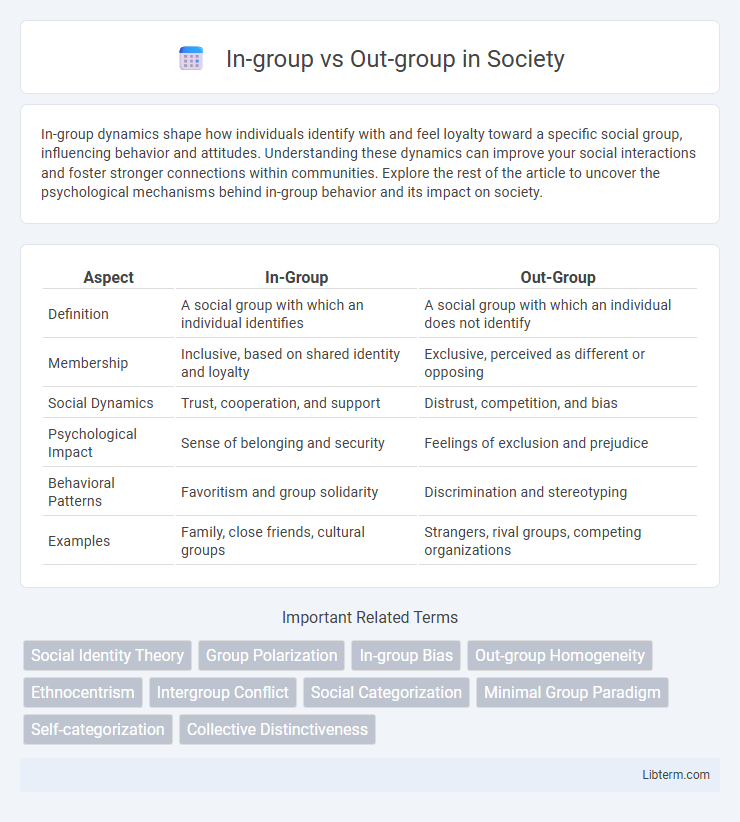In-group dynamics shape how individuals identify with and feel loyalty toward a specific social group, influencing behavior and attitudes. Understanding these dynamics can improve your social interactions and foster stronger connections within communities. Explore the rest of the article to uncover the psychological mechanisms behind in-group behavior and its impact on society.
Table of Comparison
| Aspect | In-Group | Out-Group |
|---|---|---|
| Definition | A social group with which an individual identifies | A social group with which an individual does not identify |
| Membership | Inclusive, based on shared identity and loyalty | Exclusive, perceived as different or opposing |
| Social Dynamics | Trust, cooperation, and support | Distrust, competition, and bias |
| Psychological Impact | Sense of belonging and security | Feelings of exclusion and prejudice |
| Behavioral Patterns | Favoritism and group solidarity | Discrimination and stereotyping |
| Examples | Family, close friends, cultural groups | Strangers, rival groups, competing organizations |
Understanding In-group and Out-group Dynamics
In-group dynamics refer to the interactions and bonds formed among members who share common identities, values, or goals, fostering trust and cooperation. Out-group dynamics involve individuals or groups perceived as different or outsiders, often leading to bias, exclusion, or conflict. Understanding these dynamics is crucial for addressing social polarization, improving intergroup relations, and promoting inclusive environments in communities and organizations.
Key Characteristics of In-groups
In-groups are characterized by strong social cohesion and shared identity among members, fostering loyalty and mutual support. These groups often establish clear boundaries that distinguish members from outsiders, contributing to a sense of belonging and collective self-esteem. Common values, norms, and goals reinforce in-group solidarity, influencing behavior and attitudes toward out-groups.
Defining Features of Out-groups
Out-groups are characterized by perceived differences in values, behaviors, and social norms that distinguish them from the in-group. Members of out-groups are often viewed as less trustworthy, less cooperative, and more threatening, leading to social exclusion or discrimination. These defining features reinforce group boundaries and contribute to stereotyping and prejudice.
Psychological Foundations of Group Identity
Group identity is rooted in social categorization, where individuals classify themselves and others into in-groups and out-groups based on shared characteristics. This categorization triggers cognitive processes such as in-group favoritism and out-group discrimination, reinforcing self-esteem and social cohesion among in-group members. Psychological theories like Social Identity Theory emphasize that group identity forms through the internalization of group norms and the desire for positive social distinctiveness.
Social Implications of In-group Favoritism
In-group favoritism fosters strong social bonds within groups but often leads to prejudice and discrimination against out-group members, intensifying social divisions. This bias shapes social identity and group dynamics, influencing resource allocation, decision-making, and intergroup relations. Understanding in-group favoritism is crucial for addressing social inequality and promoting inclusive social policies.
Consequences of Out-group Bias
Out-group bias often leads to stereotyping and discrimination, which can marginalize individuals and create social divisions. This bias contributes to increased conflict and reduced cooperation between different social groups. Psychological effects include lowered self-esteem and increased stress for those targeted by the bias, impacting overall societal cohesion and mental health.
In-group vs Out-group in Modern Society
In modern society, in-groups often form around shared identities such as culture, politics, or social interests, fostering strong bonds and mutual support among members. Out-groups are frequently perceived with suspicion or exclusion, which can lead to social polarization and intergroup conflict. Understanding the dynamics between in-groups and out-groups is essential for promoting social cohesion and reducing prejudice in diverse communities.
Strategies to Bridge In-group and Out-group Divides
Effective strategies to bridge in-group and out-group divides include fostering intergroup contact through cooperative activities that emphasize shared goals, which reduces prejudice and builds trust. Encouraging perspective-taking and empathy helps members recognize common humanity and diminish stereotypes. Implementing inclusive policies and communication that highlight mutual respect and collaboration promotes a cohesive environment where diversity is valued.
Impact of Group Dynamics on Personal Behaviors
In-group and out-group dynamics significantly influence personal behaviors by shaping individuals' self-identity and social interactions. People tend to conform to the norms and values of their in-group, which enhances social cohesion but can also lead to bias and discrimination against out-group members. These group dynamics impact decision-making, empathy, and conflict resolution, often reinforcing stereotypes and social divisions.
Building Inclusive Communities Beyond Group Boundaries
Building inclusive communities involves actively bridging the divide between in-group and out-group members by fostering empathy, understanding, and shared goals. Emphasizing common values and celebrating diversity reduces prejudice and strengthens social cohesion. Creating opportunities for meaningful interactions across group boundaries enhances trust and collaboration, promoting a unified community identity.
In-group Infographic

 libterm.com
libterm.com